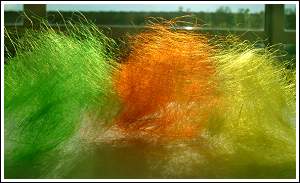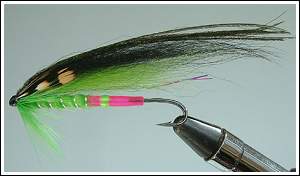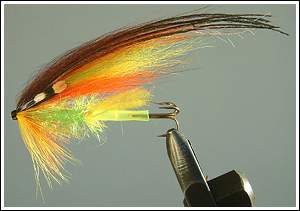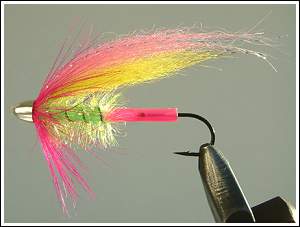|
Coloured tubes. Perspectives.
by Jurij Shumakov

Colored transparent bodies on mirror
It is
absolutely true that Scandinavia is one of the leaders in the
fly-fishing world today. And not only in equipment design, but in fly
pattern design too. Living here in Sweden for more than 12 years, I
have never stopped to be amazed at just how creative, innovative and
careful in tying Scandinavian tiers are. But a portion of critical
distance is never useless, even when dealing with absolute guru
products.
When I saw,
for the first time back in 2004, the fluorescent coloured tubes
described in an article by Michael Frödin in the Swedish fishing
magazine "Fiske för alla", I wasn't much impressed. Perhaps
because of the way the innovation was presented. Lurid photo of
coloured cone heads of about the size of my fist, with coloured leaps
made from fluorescent tubing staring at me on the title page clearly
led me to the conclusion this was a pure advertisement trick, with the
aim of impressing and catching customers, rather than fish. The effect
of the photo was enhanced by the use of UV light. Size of that leap at
front of cone head is about 1mm in diameter in reality, so with fish
watching fly 99% from behind and below this coloured bijouterie can
hardly be seen at all. The rear coloured part of tube can be easily
replaced by coloured silicone tubing on any usual tube, like
transparent plastic or metal ones, without significant changes in fly
appearance. Three flies presented in that article were evening or
night patterns, one had dense tinsel body, and only one fly was a
clear illustration of the idea. So at first sight, from my point of
view, the idea looked like a "dead baby" at the time.
When I look at
any fly, especially tied on tubes, I first look how body is built. On
the flies presented in that historical article, nothing was new, just
ordinary tube fly bodies. But since I was always looking for as much
transparency and translucency as possible in my flies I returned to Frödin's
idea of transparent coloured tube flies some years later. The reason
was pretty simple: the second photo of that article, where only tube
bodies were shown. Those examples of bodies were half covered in
non-transparent flat tinsel, which heavily reduced the positive side
of idea, while front was tied with sparse synthetic dubbing.
My idea to
exchange flat holographic or any other tinsel with something that
helps save transparency sat lurking at the back of my head for quite a
long time. Solution came when I was working with a balanced and
coloured tube system. Highly reflecting and fine new materials can be
used, not only to enhance the wing with glimmering and colour, but
inserted in transparent tube they can improve body appearance too.
Those strands of different materials could be fixed inside of body
tubing by smaller front tube, and glued with Super glue. They did not
reduce place for tippet material, or affect ability to set hook eye
directly into the fly body.

Coloured tubes with flash inside.
Inserted Micro Crystal Hair, mix of Holographic silver and Midge
Crystal Hair and Krinkle Mirror flash
Using set of
tungsten micro tubes from German company WURM Tungsten Products, I
easily solved problem of fly balance without using cone heads. Those
compact tubes with a weight of commonly used size M brass cone heads
allow me to build perfect fly with small and accurate head, either
adjusting colour of front plastic leap to head colour, or making it
contrast. The outer diameter of tungsten tube is exactly as plastic
tube used for body, and small enough to be covered by sparse dubbing
without creating bulky silhouette. Tubes produced in silver, gold,
copper and gun smoke colours provided a range quite broad to cover my
needs.

Serebrjanka dubbing
Each idea must
be digested and matured. Often that process has a few steps. Another
trigger to improve transparency of body occurred when I was dyeing a
portion of Caucasian Serebrjanka goat hair. I brushed a patch of hair
and, after cleaning the brush, I left hair curled up in ball on my
table. Hours later, when I came back to the kitchen, the sun was
lighting the table with lumps of hair. They were shining like hell! In
addition, I could see through them! The new dubbing quickly became my
favourite on tube flies, where bushy body is often required. But those
"bushy" bodies on new flies have never appeared as the ones
made from dense synthetic dubbings. When I started experiments with
different transparent materials, as well as with methods of applying
on tube, the time for Fredin's coloured and transparent tubes had
finally come.
You can save
transparency if you apply suitable material, tightly applied on tube.
Certain softness of tube allows you to place ribbing, hackle and other
rounded materials firmly on place you applied them, so with a bit of
pressure they go deep into outer tubing and can hardly be moved.

Closeup showing body of Green Magenta
The use of
transparent hairs, like from Polar bear or Serebrjanka goat, in
combination with saved translucency of coloured tube body, produces an
outstanding effect and brings whole fly an appealing appearance. At
this stage, I can't say that this combination is fully developed or
present a small article. I prefer to put forward the suggestion to use
transparent tubes for those fly tiers outside of Scandinavia who can't
read Frödin's article in the original, rather than present this idea
as a confirmed and certain recommendation. I just have a feeling that
it might work, and invite other tiers to try it.
You can also
use some of the newest synthetic materials to decorate body of fly,
and at the same time save transparency, at least partly. One such
material is Crystal and Tri-Lobal hackle. The most simple, and
definitely not the worst solution to save transparency, is just to
leave whole tube without any dubbing or other materials. Such flies
have shown very good results for both Atlantic and Pacific salmon. My
favourite Sunray Shadow version, tied on slightly brownish transparent
tube, is deadly for Norwegian and Kola salmon, while Purple Shadow
hooked both landlocked and East coast American Steelhead, as well as
bright Chromies and Kings on Kamchatka Peninsula.
Preparing for
the new season and looking at my new creations, I must thank for the
idea of coloured transparent tubes, and would subscribe to Fredin's
words in that article:" To find a new solution, which allows to
make things simpler, to improve and perhaps, make for a better
appearance of fly, is definitely the real joy of the fly tier". I
would like to add, that I still have fun, and enjoy tying huge flies
with heads not bigger than 2 mm.J
Photos of flies
with coloured tube system:




*Serebrjanka
hair is still not the kind of material that you can easily purchase in
your nearest fly fishing store nowadays. A few years of close work
with the hair has given me knowledge, which could be useful for
others. Sooner or later this type of goat hair will become standard, I
believe, because it does not come from rare wild, but from domestic
farm animals. I know that fly-fishermen are becoming more and more
interested in it, so I would like to give some recommendations based
on my experience.

Natural Serebrjanka goat
hair, close veiw
When you look
for it you should pay a lot of attention to how straight the hair is.
Most Serebrjanka hair is more or less wavy. The less wavy the hair is,
the better it lies incorporated in wing. On the other hand, the hair
is so fine and soft, that as soon as fly hits the water, all hair
waves disappear, so hair becomes straight and does not affect fly
appearance. The best hair of high grade is totally straight, but to
find skin with such hair structure is very tricky business. If you are
lucky to buy a whole skin of natural and real Caucasian Serebrjanka
goat, you can find only few patches of straight hair on it. The rest
of the hair will be wavy. The question is therefore how strongly wavy
the hair on the rest of skin is. Normally, I don't pay much attention
if hair has a couple of waves. It is fairly easy to reduce waviness by
rotating of bunch of hair between fingers. Individual hairs will lose
the same direction. It gives bunch of hair more volume.
Another lesson
I have learned by experience is that it is impossible to build whole
wing from only long hair, because in water it will collapse and lose
volume. The best way to use long hair from mature animal is to place
layer of goat hair between sections of other hair, for example Arctic
fox. Usually I cover bunch of Arctic fox with thin layer of the same
colour Serebrjanka hair. On coloured wings, like hot orange or red, a
top layer of Serebrjanka over the wing gives outstanding effect: whole
wing shines like varnished. Such wings are especially effective on
flies for early or late season, when water is cold and salmon must be
"warmed up" with something really bright and shiny.

Hair from Serebrjanka
mature animal
Hair on patch
of Serebrjanka contains two types of hair: long and short. It is,
perhaps, very unusual, but guard hair of Serebrjanka is quite thick
and short, while under fur is fine but long. On some skins,
transparent guard and under fur can be found at the same time. It
gives a nice opportunity to use both types of hair for different types
and sizes of flies.
Short guard
hair is actually very nice, which I saw for the first time on skin of
immature Serebrjanka when I discovered this fantastic material. That
short hair is perfect for small flies, or to use it as under wing on
big flies instead of Polar bear. Perhaps, it is a particularity of
Serebrjanka goat that the young animal first gets dense guard hair,
and only later under fur develops in full length of about 15-25 cm. So
you can benefit from the same patch of hair material for different
purposes. I think that long, slightly waved under fur hair can be
easily turned into nice and shiny transparent natural dubbing.

Inside of shiny colours
The hair very
easy takes a dye into it, and doesn't loose its transparency. This
dubbing can be used for bodies on big and medium size flies. For
dubbing purposes, it doesn't matter how strongly waved hair is. When
you buy Serebrjanka, also pay attention to quality and transparency.
Often hair is shiny, but not transparent. Some skins contain milky
guard hair, while under fur is transparent. Such variations of hair
quality may be confusing. Just in February 2006, I checked about 30-40
Serebrjanka skins, and only 2 of them were of the right quality, while
one of them was too wavy, so I could use it only for making dubbing.
*I've written
this notice because I have already been seeing Serebrjanka hair sell
commercially in the West, but not all of those commercial products are
of a quality I would personally buy.
Text
and photos by Jurij Shumakov 2006 ©
|